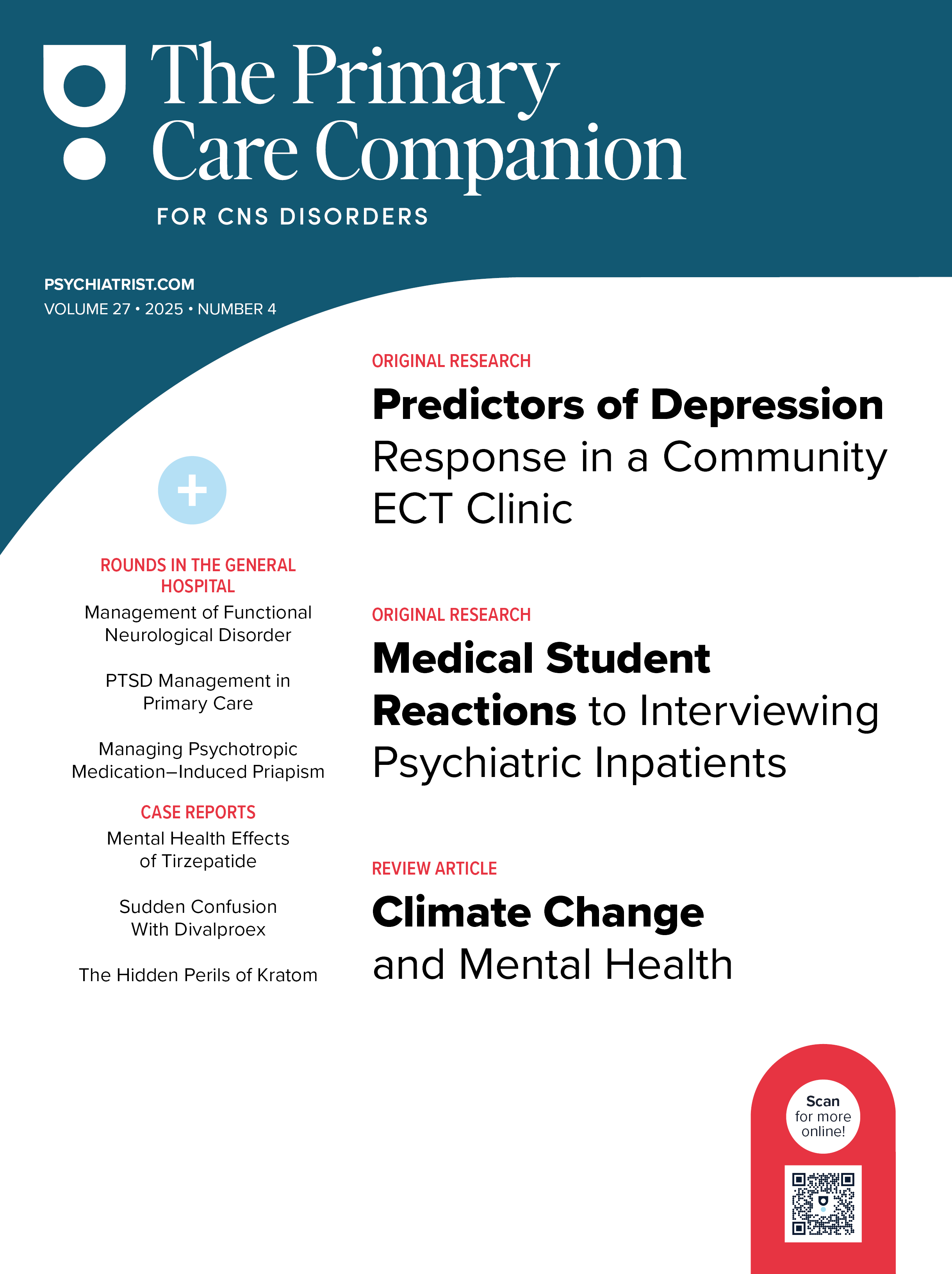Escitalopram-Induced Severe Akathisia: A Case Report
To the Editor: Akathisia, which is a distressing adverse reaction, is usually underdiagnosed or misdiagnosed in patients who are treated with selective serotonin reuptake inhibitors (SSRIs). Although cases of fluoxetine-, paroxetine-, sertraline-, fluvoxamine-, and citalopram-induced akathisia are reported in the literature, to our knowledge, escitalopram-induced akathisia has not yet been reported.1 Here, we report a case of escitalopram-induced akathisia that remitted completely after diazepam treatment.
Case report. Mr A, a 52-year-old man, consulted to our clinic in 2010 on referral by the neurology department with the complaints of feeling restless and having difficulty remaining still while seated and lying down. Initially, he was admitted to the neurology department with the complaint of headache; he was diagnosed as having tension type headache and was started on escitalopram 10 mg/d. Two days after receiving the first dose, he began complaining of severe motor restlessness and an unbearable state of never being able to sit still. Results of routine blood sample tests were within the normal range. Brain magnetic resonance imaging (MRI) revealed no abnormality in the brain. He had no remarkable neurologic findings. He did not have any personal or familial history of akathisia, psychiatric illness, movement disorder, or drug abuse. After other possible disorders were excluded, the diagnosis of severe akathisia, possibly induced by escitalopram, was made. On the Barnes Akathisia Rating Scale (BARS),2 his global score was 5 (severe akathisia).
Subsequently, escitalopram treatment was gradually stopped. Akathisia was not resolved 3 days after the permanent withdrawal of the offending medication. He still scored 5 on the BARS. Therefore, treatment with diazepam 5 mg/d was started. At the second day of diazepam treatment, akathisia was fully resolved. His score on the BARS was 0. Diazepam was gradually stopped within 1 week. Three weeks after stopping diazepam, there was no reemergence of akathisia or other extrapyramidal side effects. The patient was scheduled for a follow-up appointment by the psychiatry and neurology outpatient clinic.
Although akathisia is commonly attributed to antipsychotic medication and considered as an extrapyramidal symptom, the reports in the literature suggest varying underlying pathways.1 Deficiency of dopamine in the nigrostriatal pathway is considered to be responsible for extrapyramidal symptoms; however, serotonergic-induced inhibition of dopamine in the mesocorticolimbic pathway projecting from the ventral tegmental area (VTA) of the brain to the prefrontal cortex is thought to be responsible for the arising of akathisia. Like serotonin, norepinephrine acts similarly to inhibit dopamine in the VTA. Consequently, drugs that increase the stimulation of serotonergic or noradrenergic receptors in the mesocorticolimbic pathway theoretically could be responsible for inducing akathisia.3,4
Escitalopram is the single isomer that inhibits the serotonin reuptake produced by the racemic SSRI antidepressant citalopram. By elimination of the R-enantiomer, escitalopram would be expected to be more potent than citalopram.5 In the literature, there is only 1 citalopram-induced akathisia case, which was reported by Seedat et al.6 However, there are no literature data addressing escitalopram-induced akathisia. This may be due to the shorter half-life or the relatively recent introduction of escitalopram into the market. In our case, the possible factors that could be associated with arising akathisia are initiation of treatment with a high dose, the low affinity of escitalopram for anticholinergic receptors, and the high potency of escitalopram.
To our knowledge, this is the first case report of escitalopram-induced akathisia. Akathisia is not a mild side effect, and it has even been reported that it may be associated with suicidality.1,7 Therefore, akathisia should be considered carefully in patients who are treated with SSRIs and certainly managed acutely.
References
1. Koliscak LP, Makela EH. Selective serotonin reuptake inhibitor-induced akathisia. J Am Pharm Assoc (2003). 2009;49(2):e28-e38. PubMed doi:10.1331/JAPhA.2009.08083
2. Barnes TR. A rating scale for drug-induced akathisia. Br J Psychiatry. 1989;154(5):672-676. PubMed doi:10.1192/bjp.154.5.672
3. Akagi H, Kumar TM. Lesson of the week: akathisia: overlooked at a cost. BMJ. 2002;324(7352):1506-1507. PubMed doi:10.1136/bmj.324.7352.1506
4. Lipinski JF Jr, Mallya G, Zimmerman P, et al. Fluoxetine-induced akathisia: clinical and theoretical implications. J Clin Psychiatry. 1989;50(9):339-342. PubMed
5. Montgomery SA, Nil R, D×¼rr-Pal N, et al. A 24-week randomized, double-blind, placebo-controlled study of escitalopram for the prevention of generalized social anxiety disorder. J Clin Psychiatry. 2005;66(10):1270-1278. PubMed doi:10.4088/JCP.v66n1009
6. Seedat S, Lockhat R, Kaminer D, et al. An open trial of citalopram in adolescents with post-traumatic stress disorder. Int Clin Psychopharmacol. 2001;16(1):21-25. PubMed doi:10.1097/00004850-200101000-00002
7. Sachdev P. The development of the concept of akathisia: a historical overview. Schizophr Res. 1995;16(1):33-45. PubMed doi:10.1016/0920-9964(94)00058-G
Author affiliation: Department of Psychiatry, Ataturk Education and Research Hospital, Ankara, Turkey.
Potential conflicts of interest: None reported.
Funding/support: None reported.
Published online: December 30, 2010 (doi:10.4088/PCC.10l01016blu).
Prim Care Companion J Clin Psychiatry 2010;12(6):e1
© Copyright 2010 Physicians Postgraduate Press, Inc.




